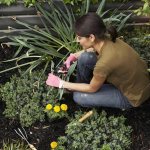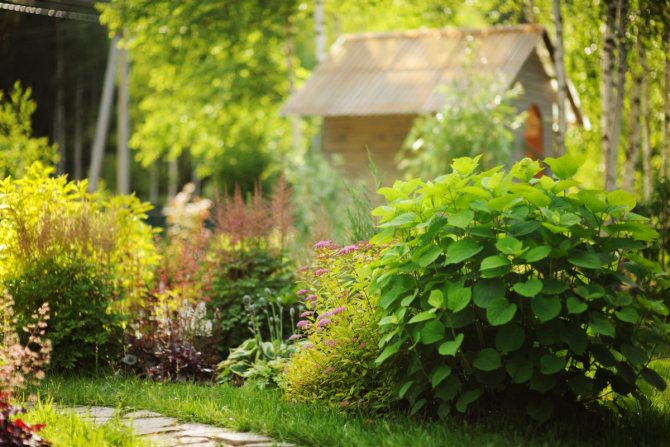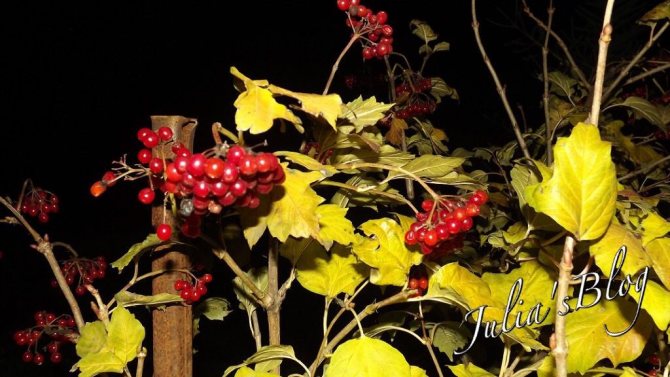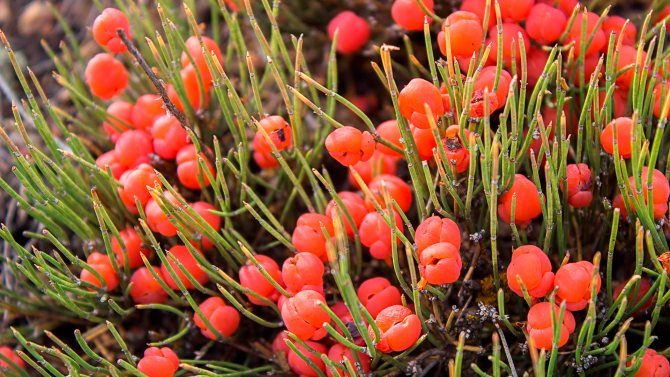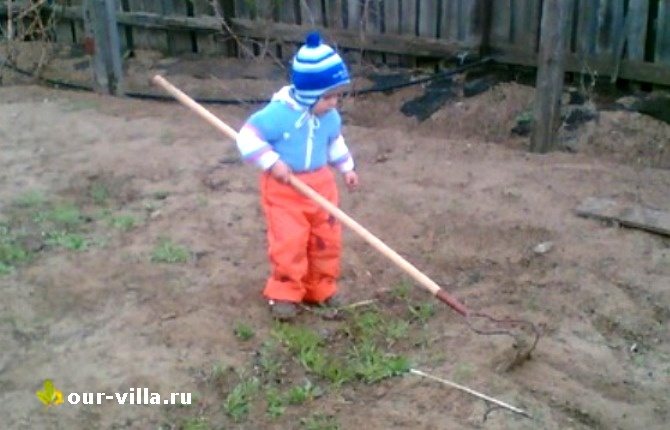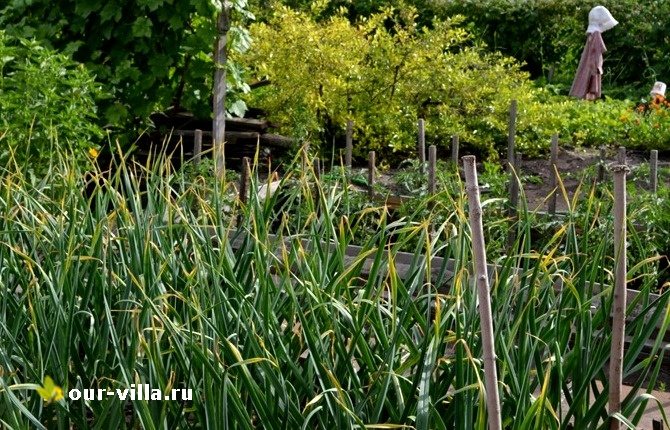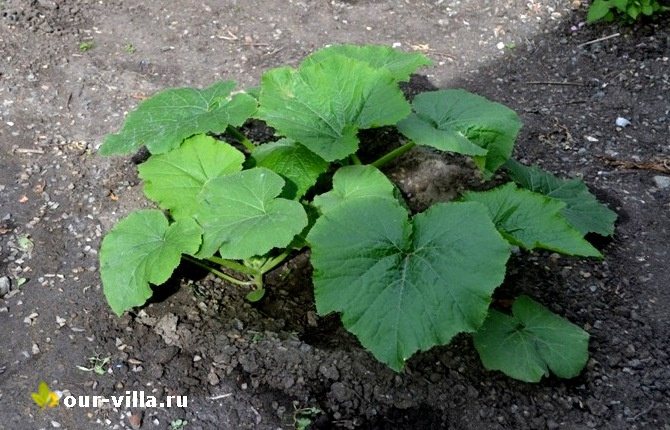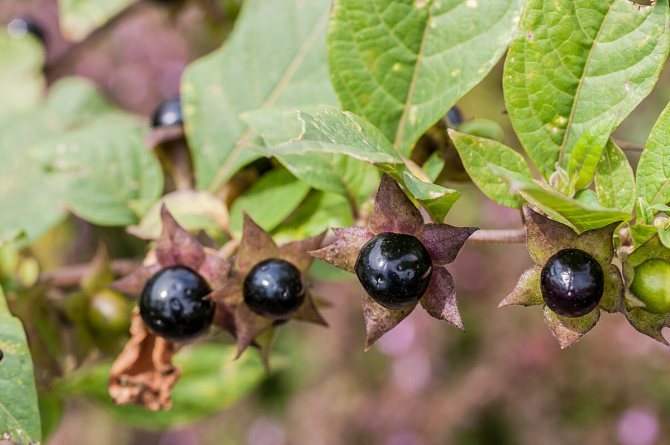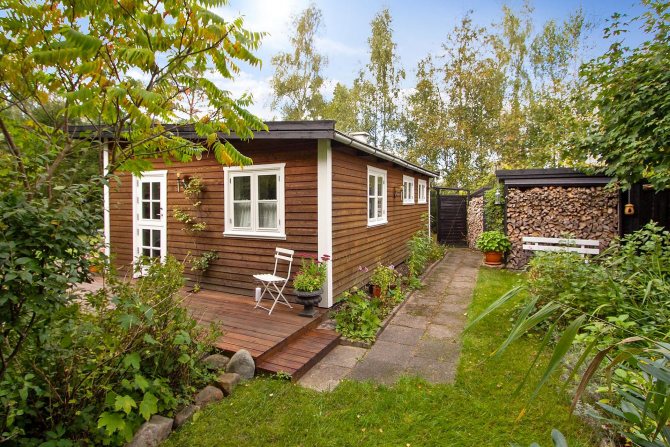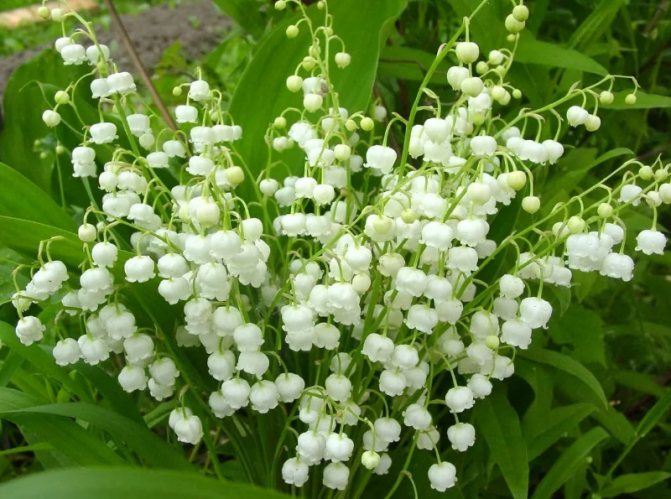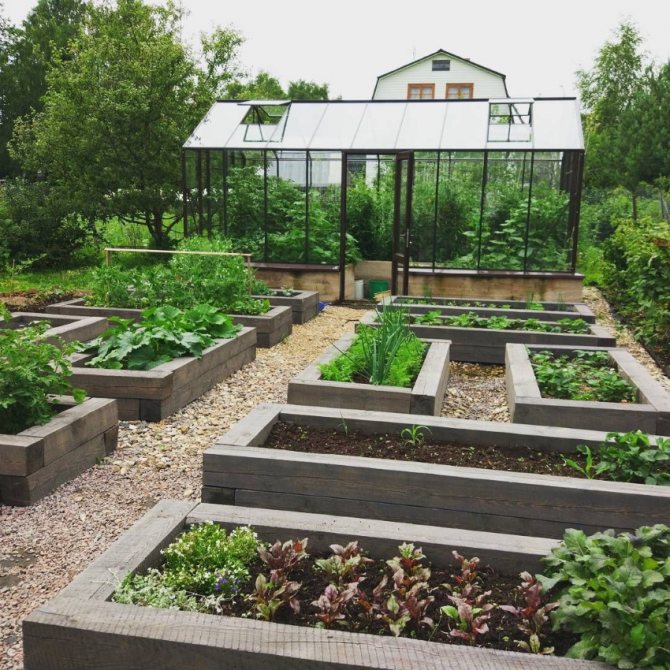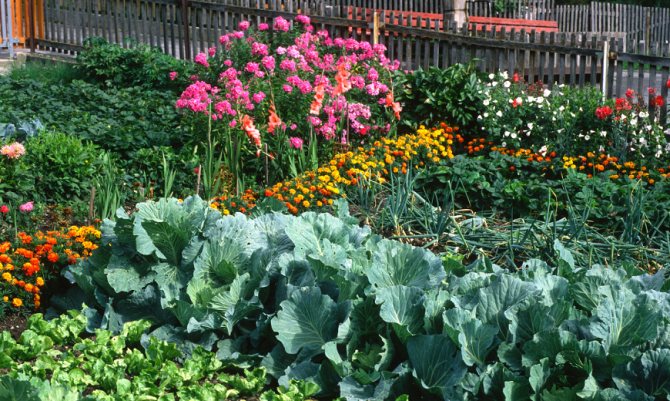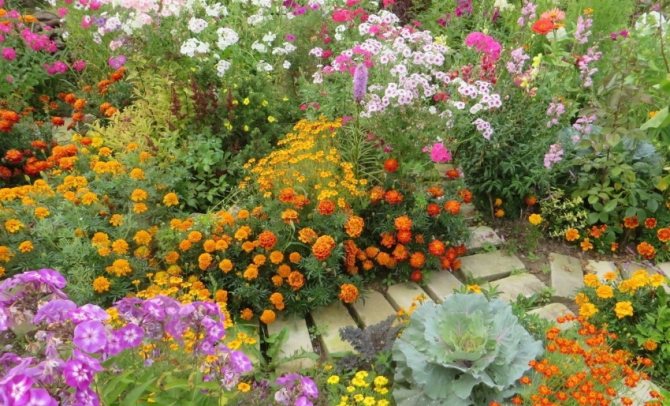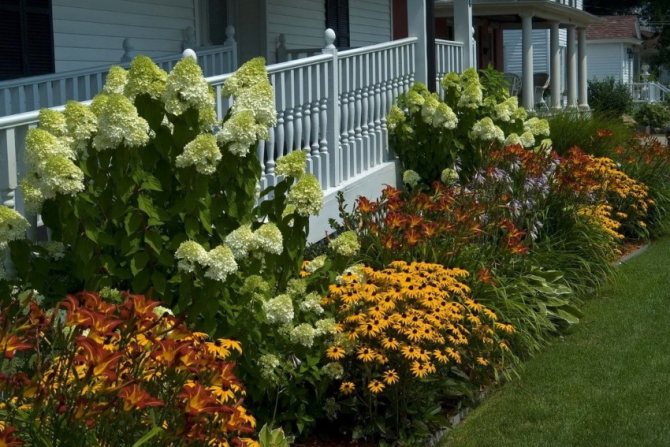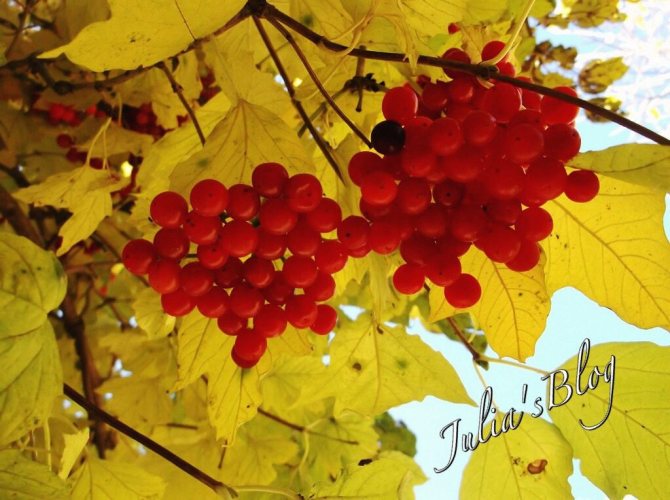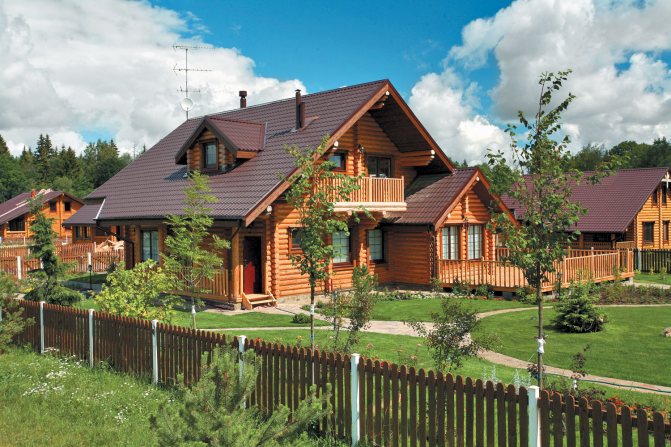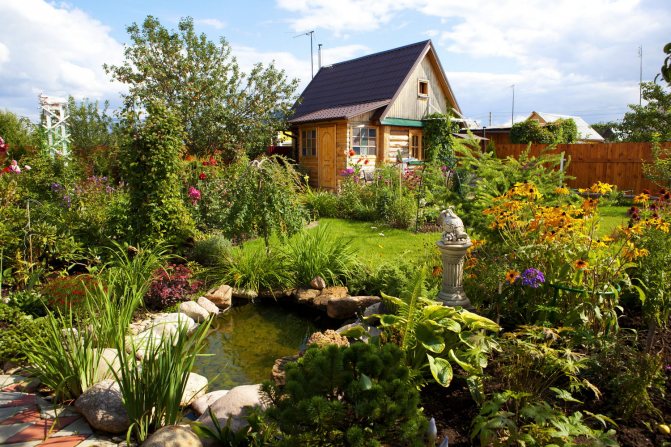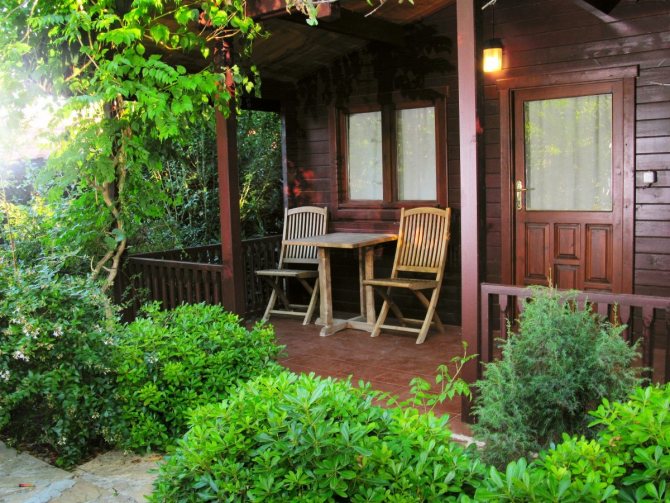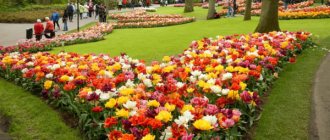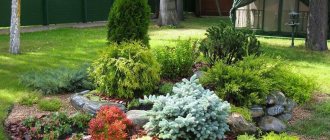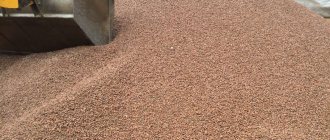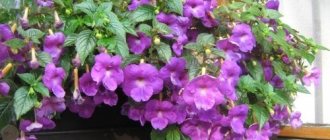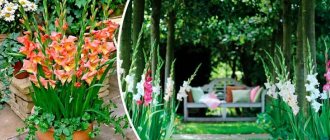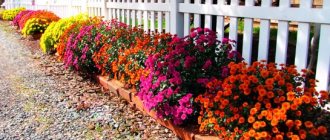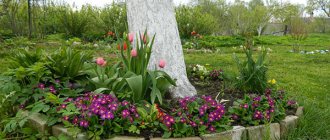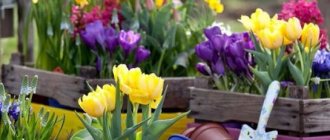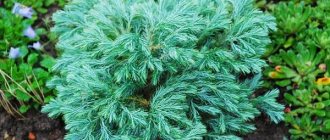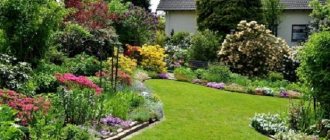In order to be ready to meet the new summer cottage season, many summer residents consider it their main task to stock up on as many seeds as possible and place all this on their site. On the one hand, such a desire is very commendable, but at the same time it is worth remembering what dangers are fraught with plants that are planned for planting. Undoubtedly, planting beautiful ornamental plants will beautify the site, but on the other hand, is it worth planting potentially dangerous plants where children or pets will play. For this, a list of plants has been compiled that carry a rather great danger, which are not recommended to be planted next to the house on the site.
Choosing a summer house in winter
The very first mistake was made when buying our first suburban area. With the approach of spring, we began to "planting itch", as the gardeners say, we wanted to buy our own dacha as soon as possible. In February we drove around several sections, among which we liked only one. And already in March they became the owners of their own dacha.
Of course, during this period, snow still lay on the site, which prevented an objective assessment of all the advantages and disadvantages of this summer cottage. For example, of the seven currant bushes that delighted me so much when examined, half turned out to be old and no longer fruiting specimens, and the other half were dead bushes. Thus, we not only had to buy new seedlings, but also spend time clearing the old berry plant.
In addition to the nature of the vegetation, snow can hide many other unpleasant surprises. It often happens that the owners of a heavily overgrown area mow all the growth with a trimmer and numerous stumps are completely invisible under the snow. And in the spring, the new owner receives a plot full of cherry and plum shoots, which is extremely difficult to get rid of.
What to plant in a large area. Landing planning
Before planting a summer cottage, you need to think over and calculate everything. Initially, we decide on what exactly we want to see on our site.
A few questions will help a novice gardener to decide, from the answers to which in the future you need to build on.
- What vegetables and berries are preferred for the whole family?
- Are you planning on canning vegetables for the winter?
- How much time do you plan to spend on the site?
- Is his area well lit by the sun?
- Are the climatic conditions suitable for growing berry and vegetable crops?
These factors are the most important. There are, of course, other nuances, for example, the quality of the soil, its drainage, but they can be solved. The land can be improved and drainage can be provided. And when the site is in constant shade, if the sun hides the foliage of the trees, for example, or there is a cold climate in the area where the dacha is located, then there will be no luck in this option, and it will still not be possible to grow all the crops that we would like.
It is necessary to plan a site on a large sheet of paper, preferably a millimeter one, in this case you can clearly see what, where and how best to place it.
To plan the landing, you must:
- Draw a plan of the summer cottage area on paper in A3 format. A sketch will not help in this case, therefore it is better to make accurate measurements.
- Designate on the site plan all existing buildings and those that are planned: a barn, a house, outbuildings, a gazebo, a pool, flower beds, a place for compost, a recreation area (barbecue). If a vineyard is planned, then it should be noted separately.
- Make several copies of the resulting site plan.
- In free space, zones should be designated based on the degree of their illumination: well-lit areas and shadow.
- Identify the source of the water.
- Select locations for greenhouses or greenhouses for vegetables. They will require a territory that is voluminous in terms of area. Also, do not forget about the distance to the tracks (at least 30 cm).
Selection of the "bare" site
A plot without large trees and shrubs may seem like a plus to many, because this allows you to independently plan a design without cutting down old specimens and disposing of branches. In addition, it gives a lot of space for planting light-loving crops.
But still, an empty area is not always a virtue. And the point is not so much that in such areas your life flows before the eyes of your neighbors, and in windy weather the winds are stronger there. The lack of woody vegetation is often due to more serious reasons than the dislike of the previous owners for trees.
There are no trees in new (freshly cut) plots - this is quite logical, but at the dachas of partnerships that were created more than 30 years ago, scarce vegetation should alert. In our case, the minimum of trees was the result of the proximity of groundwater and regular spring flooding. As a result, we had to make a lot of efforts to find the breeds suitable for such conditions.
But at the dacha of relatives, fruit trees hardly grow due to the fact that the soil is too sandy.
Read about how we saved plants in our country house from spring flooding in the article Spring flooding of a site - how to save plants?
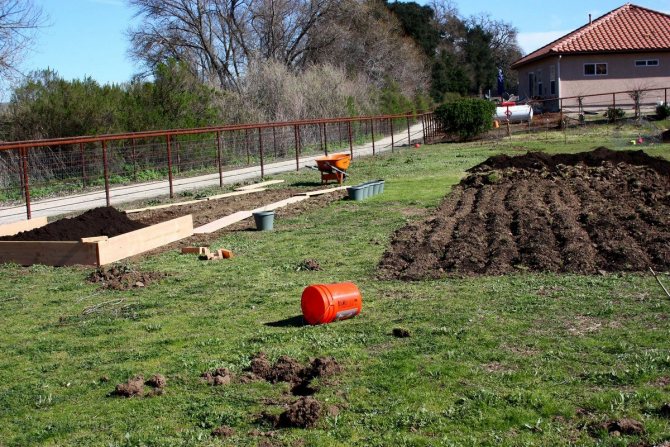
A plot without large trees and shrubs may seem like a plus to many.
What can not be grown in the garden
If the State Duma adopts a bill on stricter responsibility for growing wild-growing narcotic plants in the current edition, then the maximum fine for citizens will be four thousand rubles, for legal entities - 100 thousand rubles. “Parlamentskaya Gazeta” has figured out what exactly cannot be grown in the garden and in what quantity.
Be careful with the Hawaiian rose!
The draft law was developed by parliamentarians of Kabardino-Balkaria. They submitted it to the State Duma in December 2020. The document is planned to be considered in the first reading on September 25.
Legislators from the region, where drug-containing "weeds" bloom especially violently, propose to amend the article of the Code of Administrative Offenses of the Russian Federation, establishing responsibility for "failure by a landowner or land user to take measures to destroy wild plants containing narcotic drugs or psychotropic substances or their precursors." It was proposed to double fines for individuals (the maximum fine is four thousand rubles instead of two thousand), two and a half times for officials (10 thousand rubles instead of four thousand) and legal entities (100 thousand rubles instead of 40 thousand).
Read on
Cannabis is proposed to be removed from the drug list
We are talking about very specific plants containing narcotic substances - their list is enshrined in the decree of the Government of Russia. They will be fined not only for grown hemp, coca bush, mushrooms containing psilocybin or psilocin (the so-called hallucinogenic mushrooms), or sleeping poppy, but also for rather exotic herbs. For example, this is a blue lotus (a plant of the Nymphea caerulea species) or cacti containing mescaline (a psychedelic from the group of phenylethylamines). On the same list, khat - a drug from this plant causes excitement and dulls pain receptors.
Meanwhile, there are other plants that at first glance are not associated with drugs. For example, bashful mimosa (Mimosa hostilis), which in Brazil is used for a decoction against toothache. In the same category, Hawaiian rose (Argyreia nervosa plant), horsetail ephedra and diviner sage (Salvia divinorum plant). However, their appearance in the government list is not accidental - their intoxicating properties were revealed after analyzing the constituent components of spice - narcotic smoking mixtures. Therefore, in large volumes, these plants are capable of causing drug intoxication. And, accordingly, they are in demand in the criminal market.
The Federation Council believes that gardeners should not "play small children". Deputy Chairman of the Committee of the Chamber of Regions on Defense and Security Alexey Kondratyev
assured "Parlamentskaya Gazeta" - a person who is engaged in gardening or gardening, perfectly distinguishes wild plants from agricultural crops. “Hemp is definitely distinguished from thistle in the villages. And to say that a person does not know what is growing in his garden is not entirely correct. I believe that local police officers should carry out appropriate work with citizens and warn people about responsibility for growing or not destroying such wild plants, ”the senator said.
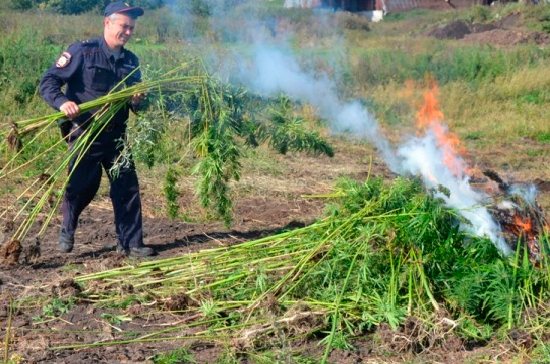

It turned out that the problem that worries the Kabardino-Balkarian deputies worries not only the southern regions with favorable climatic conditions for the growth of narcotic herbs, but also the colder Russian territories. Photo: Ministry of Internal Affairs of Russia
Meanwhile, Alexei Kondratyev does not hide - he is a supporter of more decisive measures to combat drugs. “Personally, I don’t think that a double increase in fines will somehow affect the situation as a whole. What is four or ten thousand rubles, if we are talking about profits from the sale of drugs, calculated in thousands of dollars? These fines will not radically hit the economy of the drug business, ”the parliamentarian said.
On the other hand, according to the senator, there is a danger for those who have historically grown hemp and poppy in the regions as a vegetable garden - for example, for the production of hemp or hemp oil. “Here we need to clearly regulate the process, coordinate the“ crops ”with law enforcement agencies. The topic should be more seriously monitored - this is my personal position, ”Aleksey Kondratyev told Parlamentskaya Gazeta.
We can say that the sanctions are not harsh enough, that it is not very effective. But the fines on the roads have increased, people have begun to violate less, right?
The State Duma is ready to support the initiative to raise fines for narcotic wild plants. This was reported to "Parlamentskaya Gazeta" by the deputy co-rapporteur on the bill Otari Arshba
... “Any step towards the fight against drugs, any prohibitive measure here is a blessing,” he is convinced. - We can say that the sanctions are not severe enough, that it is not very effective. But the fines on the roads have increased, people have begun to violate less, right? Therefore, to assess the effectiveness, data on law enforcement practice are needed. We are ready to support this initiative. "
Two cacti with mescaline - two years in prison
It turned out that the problem that worries the Kabardino-Balkarian deputies worries not only the southern regions with favorable climatic conditions for the growth of narcotic herbs, but also the colder Russian territories. Criminal cases are being initiated in the Smolensk and Orenburg regions. And recently a court in Perm passed a criminal sentence (one year suspended imprisonment) to a 64-year-old labor veteran. The reason was that the opium poppy is in full bloom on the pensioner's garden plot - another plant, which, along with cannabis, is a popular raw material for the production of drugs.
The most "free" conditions are for psilocybin mushrooms and hemp. For these species, the large cultivation size starts at 20 plants.
The man had 467 (!) Wild poppy bushes in his garden. It turned out today that Igor Troshev
he tried to provide for his drug-addicted son in this way, and the wild plant appeared on his site not by accident. And this is already serious - the suspended sentence may become real. According to the current legislation (Art. 231 of the Criminal Code of the Russian Federation), in order to get a real prison term (up to two years in prison) for cultivating "sleeping poppy" "on a large scale", it is enough to grow 10 such plants.
The same - a limit of 10 plants - is set for mimosa, sage, ephedra and Hawaiian rose. But for criminal prosecution for growing a cactus with mescaline, it is enough to grow only two such plants. A little more (four plants) - for kata and coca bush. The most "free" conditions are for psilocybin mushrooms and hemp. For these species, the large cultivation size starts at 20 plants.
Landings without a plan
Having barely bought a new dacha, I want to run to the nursery and buy up everything that catches my eye there. But only later you have to run around the site not a single day and think where to plant your purchases? Sometimes we do not find a worthy place for new plants and plant according to the principle "let it be here for now."
In addition, our plans often change. We understand that it would be better to make a pond instead of a flower garden, and that tree over there interferes with the path. Some of the plants purchased for our summer cottage were more fortunate, and I transplanted them only once. But there are also such poor fellows who were transferred from place to place from 3 to 5 times.
And if many perennials perceive this relatively painlessly, then with each tree transplant, you, in fact, take a whole year of life. The forces that they use to adapt and restore damaged roots could go to the growth and development of the tree.
Therefore, for a start, it is better to plan the site and completely complete the arrangement of the main design elements (flower beds, paths, pond, etc.). And only after that, go shopping for plants. And - preferably with a ready-made list in hand.
A beautiful garden with your own hands. Mini-flower beds for your favorite summer cottage
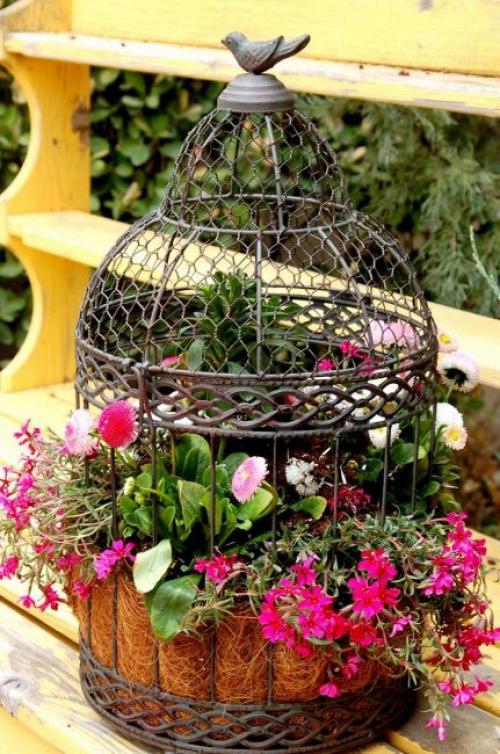

A flower bed from a decorative bird cage
That there was no flower bed in the country is incredible. Usually, these are beautiful combinations of luxurious colors, decorated in a certain style. But, unusual mini-flower beds will help to diversify, give zest to the design of the cottage. They are easily made from scrap materials. The main component is garden land. Without her, no idea will come true.
Used shoes
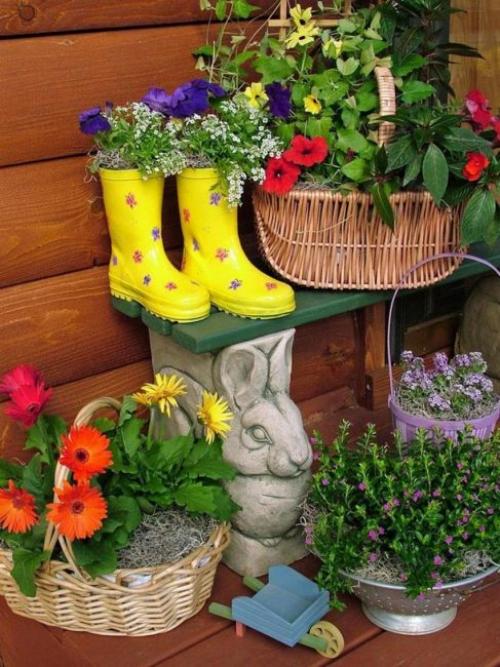

Rubber boots as a flower pot
Not a single family experiences a shortage of material in the country. This is the best planter for a mini flower garden. Such designer crafts decorate not only the porch, but also the playground, bench, fence.
Abandoned by everyone, forgotten shoe on the lawn, in which flowers have grown - spectacular and unusual. Children will appreciate this design.
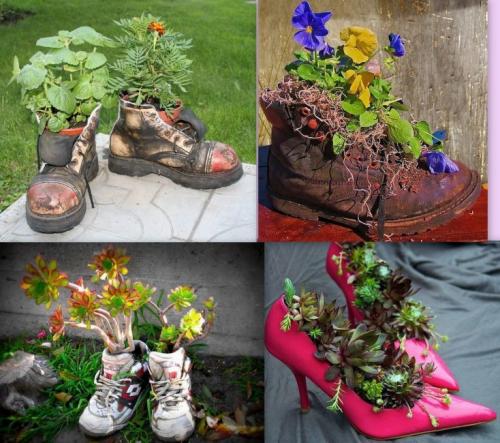

A family design project of jewelry will be a composition of several pairs of shoes
A harmonious combination of boots or shoes of family members will decorate the steps in a stylish and unusual way.
Dishes
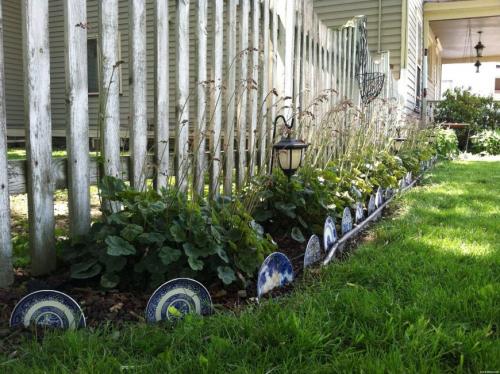

Plates can serve as a flower bed fence
Broken dining utensils, a leaky old bucket are suitable for creativity.
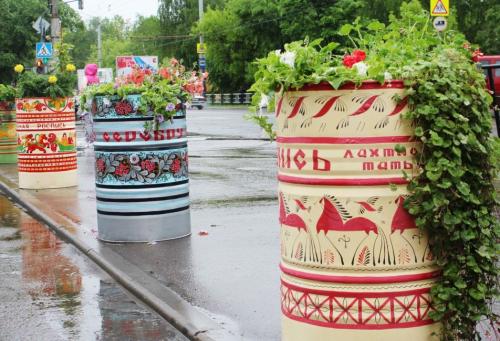

Even an old iron barrel can be given a new and unconventional look
Take the paints in your hands, right away the old customary for giving pots, buckets, jugs and plates will be transformed before our eyes.
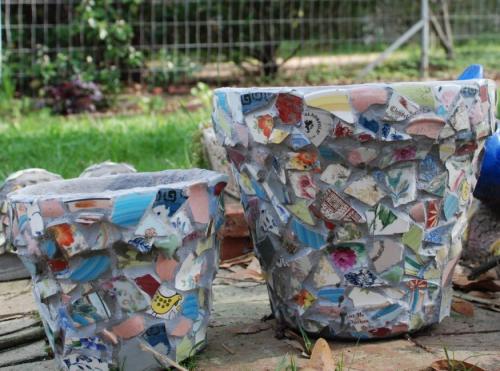

Flower pots are pasted over with pieces of broken dishes
Try to place decorations for a summer residence, in places that are unusual for us:
- on a bench by the garden path
- on the shore of a natural or artificial reservoir
- along buildings, greenhouses, fence or garden ridges
- just on a stool or old chair
In any case, the space will sparkle with new colors, it will become more fun, more unusual.
Planting conifers too close to each other and close to buildings
The main difficulty faced by a novice gardener is the difficulty of forecasting. What will a seedling look like in adulthood? Theoretically, we know that this tree will become five meters tall, but it is often difficult for us to imagine how much space it will eventually take.
This is especially true of conifers, which do not grow quickly and are often sold as crumbs. Because of this deceptive appearance, compact conifers are very often planted close to each other or to other plants. Subsequently, all participants in such plantings begin to suffer and lose their appearance. The only thing that can save the situation is a regular and fairly strong haircut. After all, transplanting conifers in adulthood is a very risky business.
Therefore, so that young seedlings in the first years are not lost during remote planting, they can be companions with annuals or perennials that can easily tolerate transplantation.
The miniature size, as well as the desire “for the Christmas tree to look through the window” (as it was with me), leads to the fact that conifers are planted close to the wall of the house. As a result, the part of the crown facing the house does not receive enough light and looks depressed, and the dampness that forms as a result of the tight adhesion of branches to the wall is not useful for either the building or the tree.
Under the windows, it is better to plant compositions of dwarf rocks, which, growing up, do not close with the wall. And when growing large trees, the crown diameter at the most mature age must be taken into account, plus one or two meters in stock.
What to plant in the garden to make it beautiful. Unpretentious plants for novice summer residents
Many out-of-town holiday lovers visit the country house only on weekends, therefore, they need to choose flowers that require minimal maintenance. In addition, plants must tolerate drought well or, conversely, prolonged rains. If you plant capricious roses in more northern latitudes, then they will require daily attention, so consider options that calmly develop on their own, at least for a week.
They are undemanding to the soil and are cheerful yellow and orange marigolds. The only condition for their successful cultivation is a place lit by the sun, and this can be a patch in the middle of the lawn, and a narrow flower bed along the path, and containers suspended from the wall. Low varieties of marigolds are ideal for setting up ridges or borders.
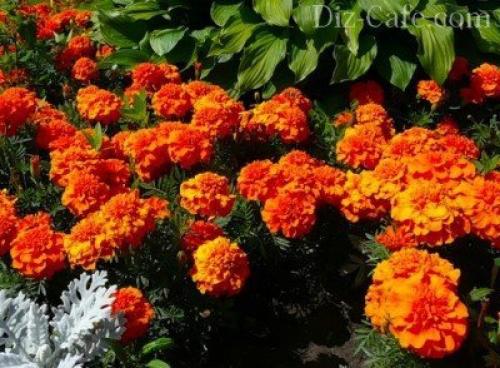

Bright monochromatic marigolds look more elegant when surrounded by plants with decorative large leaves, for example, against the background of an ordinary or spotted hosta
What to plant in the garden - a list. Growing greens, Growing vegetables. 01.08.2016. 13 9441.
For lightly shaded areas, climbing, freedom-loving nasturtium is great. It grows quickly and should be planted in areas with a lot of loose soil. In order for the nasturtium bush to retain its shape and size as long as possible, it is placed in a pot or small container. The beginning of May is the best time to plant these pink, burgundy, lilac, yellow or variegated plants.
Imopeia is distinguished by large, noticeable from afar flowers, which can decorate both the wall of the house and a trellis specially arranged for it. Imopea loves supports and has increased tenacity, so she can easily "pounce" on any object standing nearby - a bench, a tree, a corner of a house. These beautiful flowers with large buds love sunlight and organic fertilizers.


Buying large-sized vehicles
It takes time for plants to grow, to gain strength and to beautify the landscape with dignity. But having funds, you can purchase adult specimens in full bloom in a container or with a clod of earth (using special technology). But such an offer is not cheap.
In an effort to give my garden a finished look as soon as possible, I also preferred adult seedlings. But since my budget was limited, most often I purchased plants with bare roots from the market (fruit and ornamental deciduous trees and shrubs) or from collectors who dug out conifers by hand without special equipment in my presence.
Large-sized ones after a similar, not too sparing transplant, require very careful care. In particular, we covered the thuja with sacking for the winter for the first three years so that they would not get burned. As a result, it often turned out that the seedlings bought in crumbs practically caught up with their larger counterparts, who spent much more time on adaptation.
Sod planting
I not only made this ridiculous mistake on my own, but also continue to observe it among novice summer residents. And this is quite understandable - the flowers are ready for planting and you want to do it beautifully, and thorough preparation of the soil is not a quick and time-consuming task. As a result, mediocre weeding is carried out, leaving most of the roots of perennial weeds in the ground.
In the future, it becomes more difficult to cope with weeds, and the flower garden cannot have a neat appearance. Therefore, for myself, I decided to postpone the rush, so as not to complicate my life in the future.
If there is no physical opportunity to dig up a place for a flower bed and carefully select all the rhizomes by hand, then this corner of the garden can be covered with dense mulch (for example, made of cardboard) for one season, and then most of the weeds will die on their own. There is also a chemical method for removing unwanted vegetation, but do not forget that herbicides are extremely harmful to soil microorganisms.
The main principles of garden planning
Maximum light... Most vegetables are light-requiring. It is better to choose a well and evenly lit area for the garden. For example, tomatoes reduce yields even if they are in the shade for about 2-3 hours a day. To ensure that both sides are heated evenly, the beds are oriented from north to south.
Calculate your strength... Set aside as much space for your garden as you can - and want! - process. If you visit the country house only on weekends and then not every time, it hardly makes sense to plan a large vegetable garden and strive to plant as many crops as possible.
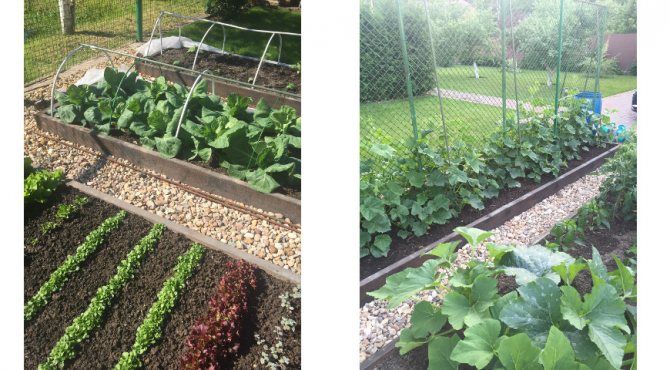

Wide beds are not always good. Traditionally, in our gardens, the beds are made 100-120 cm wide. This saves the useful area of the garden, but makes it difficult to care for the plantings: stretching is not always convenient. The 70 cm wide beds are much easier to maintain. For older people, not only narrow, but also raised beds are convenient, over which you do not need to bend over. High beds are increasingly dressed in a frame made of boards, into which fertile soil is then poured. In this case, both water and fertilizers are used by plants more rationally.
Do not get carried away by beds of complex shapes: this makes it difficult to care for and worsens the conditions for the plants, since in the corners the ground dries out faster, so plants can develop unevenly.
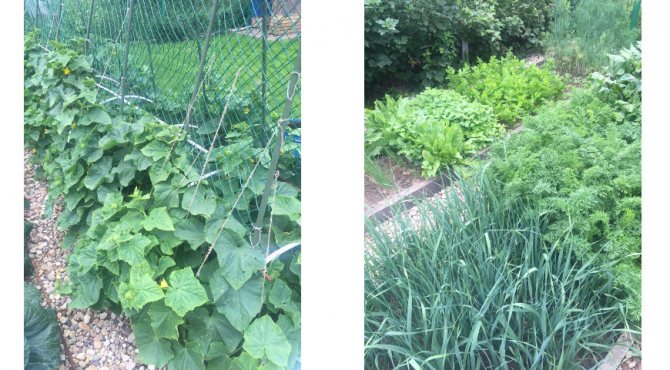

Aisles between beds should not be the same width... For normal care, a distance of 40 cm is sufficient; for high beds add 20–35 cm due to the presence of walls. If the garden is large, a through path is needed for passage and walks, you can also make a recreation area. However, before you start forming the beds, think about how to lay the paths. They should be wide enough, lead to all corners of the garden, it should be convenient not only to walk on them, but also to carry a cart.
Don't be afraid to combine culturescompatible with each other. The combination of different forms of foliage, shades of color and height of plants on the same bed looks much more attractive than monotonous rows of plantings.
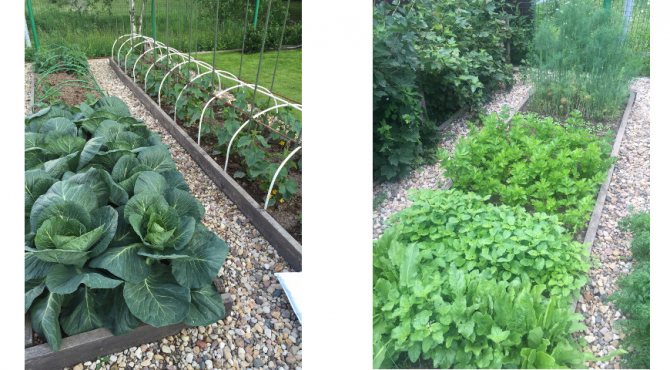

Flower beds without limitation
Professional designers pay great attention to the bounding edge of flower beds. But summer residents in a hurry, as a rule, do not pay attention to this.As a result, over time, the surrounding vegetation begins to penetrate more and more into the flower garden, especially if the flower bed borders on a lawn.
Today on sale you can find a wide selection of border tapes. In this case, not only the appearance is important, but also the material from which the product is made. In particular, if you plan to trim the flower garden with a trimmer, then be sure to choose a tape that is resistant to such damage, which will definitely be noted on the package.
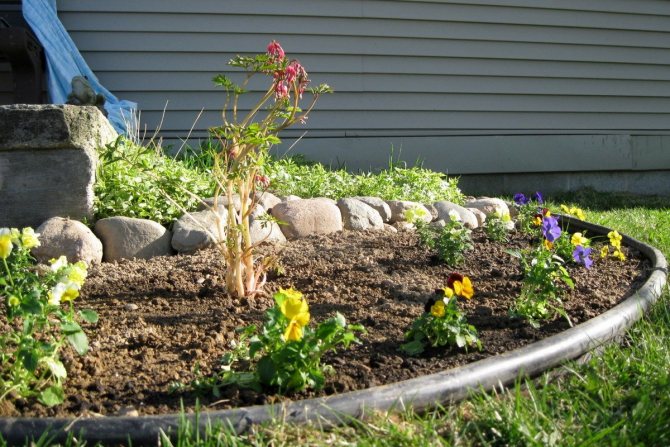

When forming a flower garden, you should pay attention to the bounding edge.
Planting ornamental plants on the principle of "everything and more"
Novice summer residents usually have enough unoccupied space, which they really want to fill with plants as soon as possible. And then the neighbors come to the rescue, who are happy to share the roots. Usually, unpretentious perennials are given as a gift, which require a minimum of care.
But the desires of flower growers are inexhaustible, and every year we bring something new to the garden. Subsequently, the space becomes less and less, and the donated "oldies" inevitably lose to the novelties of selection.
Moreover, unpretentious flowers are often aggressive and are actively sown and spread by roots. Subsequently, they inevitably have to be evicted behind the fence or even sent to compost.
To prevent this from happening, it is better to immediately realize that it is very difficult to fill the entire site in one year, and it is not at all necessary.
Read about the rules for planning a plot in our material First steps after buying a land plot.
When the plant determines the place, and not vice versa
At first, the main driving force behind the purchase of plants was the desire to become the owner of a particular bush or flower. As a result, I lost a lot of plants - they could not settle in the place chosen for them (without taking into account the requirements for living conditions).
Most often it was a banal landing of light-loving ones in the shade, because there was no free space in the sun, and, on the contrary, the landing of shade-tolerant ones in the sun. With experience, I realized that a plant is not a lifeless piece of furniture. And this practice will not lead to anything good.
Now, if space is vacated on my site, I first of all look at the conditions (sun or shade), and then at the environment. And already on the basis of these data, I select a flower that will like the conditions and at the same time it will fit as much as possible into the design of this corner of the garden.
That being said, I try to buy multiple plants of the same variety whenever possible, as most flowers and ornamental shrubs look best as a group.
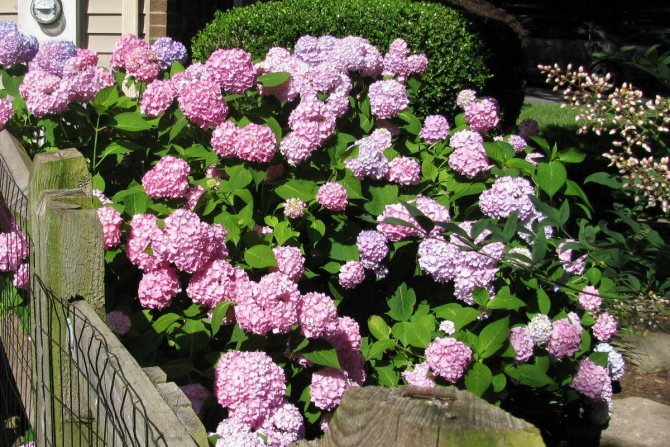

A big mistake is planting shade-tolerant plants in the sun. <>
Blue lotus
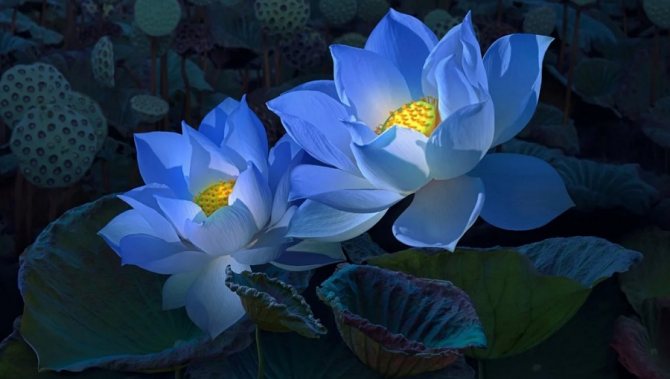

The blue lotus is a powerful plant that has a strong narcotic effect on the human body. Its leaves and petals contain substances such as:
- alkaloids;
- aporphin;
- apomorphine;
- nuciferin.
15 grams of dried petal is equivalent to taking ecstasy. Typically, blue lotus flowers are the main ingredient in smoking and aroma blends. For growing more than 10 of these plants on the site, you fall under criminal liability.
Planting valuable plants near a neighbor's fence
Even if your neighbors are friendly and helpful people, it is very difficult to predict how your relationship will develop over the years that you will be sharing a common fence. In the beginning, our new neighbors made the most pleasant impression on us. And no one could have thought that, smiling at us on weekends, these same people on weekdays (in our absence) methodically destroyed all fruit and ornamental trees and shrubs that had at least some adhered to the fence from their side.
The reason was trivial - our plants supposedly shaded their potato beds.Of course, there are norms of indentation when planting plants near the fence, in accordance with which we planted seedlings, but this was not enough for the neighbors. Later, when a scandal erupted, the neighbors demanded to plant all trees and shrubs strictly on the other side of the site (closer to another neighboring dacha).
It is very disappointing to remember how many interesting crops and valuable varieties were destroyed by unscrupulous neighbors. But the plants of the creature are vulnerable, poured boiling water, sprinkled with herbicide and remember what they called ...
How we protected ourselves from unpleasant neighborly attention, read the article Multifunctional support for plants, or How to effectively hide from neighbors.
What is useful to plant in the country that does not require special care
Eucology of consumption. Farmstead: It's already the middle of spring, which means not quite active, but still fans of gardens and vegetable gardens will like this article ...
It's already the middle of spring, which means not quite active, but still fans of gardens and vegetable gardens will like this article.
All our ancestors lived in beautiful gardens - family estates. They received the harvest in great abundance, while not wasting time on caring for their vegetable garden and orchard. Everything was planted so that the garden looked after itself. Our ancestors felt with their souls exactly where exactly which plant needed to be planted. Modern man has a little forgotten how to determine with feelings Where What and How to plant. Therefore, now we will remember a little.
Grasses must be sown in sparse patches, and not in a continuous patch, otherwise they will drown out the growth of the main crop. So let's get started.
"HERBS-HELPS"
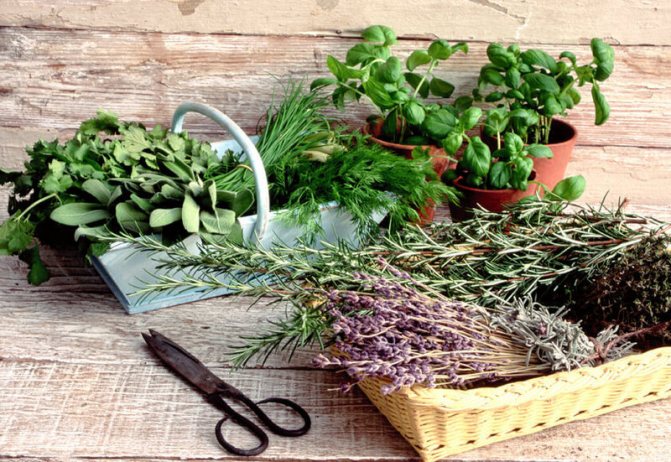

BASIL - grows remarkably, makes friends with tomatoes, improving their taste, cabbage, beans, peppers. With its "fragrant" it scares away flies and mosquitoes, a bean weevil.
VALERIAN - this herb is always advised to have in the garden, it is especially useful for compost - the roots of valerian, chicory, along with onion leaves attract many earthworms there.
HYSSOP - loves cabbage, scares away the cabbage scoop with its ethers. Grows well with grapes.
CALENDULA - good with tomatoes, it can be sown in any part of the garden: it repels various insects and some pests, for example, five-point hawkworm caterpillars - a pest of eggplant, peppers and tomatoes, the Colorado potato beetle, asparagus pests. With its phytoncides, calendula, or marigold, as the flower is popularly called, protects the garden. Where it grows, there are no nematodes in the soil and the soil itself is disinfected from pathogenic microbes. Calendula protects vegetables and strawberries from ticks and root rot. Other pests are also afraid of the presence of this plant nearby - aphids, raspberry flies, leaf-eating insects of berry bushes. Planted among roses, calendula will protect them from many diseases.
LUBISTOK MEDICINAL - especially gravitates towards beans and tomatoes, improves the growth and taste of fruits.
MELISSA MEDICINAL - friendly to everyone, it is also desirable to grow it in different parts of the garden, it attracts bees and other beneficial insects.
DAIRY ORNATE - scares off moths and mice, which means the more of its bushes will grow in different parts of the garden, the fewer mice will visit you.
MONARDA TUBULAR - grows well with tomatoes, improves the taste and growth of fruits.
MINT - has a beneficial effect on the general condition of all plants; friend of cabbage and tomatoes, scares away the cabbage scoop and cabbage white, attracts predatory insects.
NASTURTIUM - very friendly to radish, cabbage, pumpkin; growing under fruit trees, repels aphids, bedbugs and other flea beetles, whitefly, Colorado potato beetle, cabbage caterpillars. And at the end of the season it will become an excellent mulch, providing "food" and a home for soil inhabitants.
PETUNIA - protects legumes.
WORMWOOD - scares off ants, cabbage and carrot aphids, earthen fleas, whitefly.Several bushes of wormwood on the site will definitely come in handy for herbal gatherings.
CHAMOMILE - grows well with cabbage and onions, mint, cucumbers, it is planted in small quantities.
TAGETES (VELVETS) - it is recommended to plant in various parts of the site, it repels insects, exterminates the nematode in the soils affected by it, an excellent material for mulching and composting. It gives a lot of seeds, attracts beneficial insects, is unpretentious, shades vegetables and the soil, protecting them from overheating, and is also very aromatic.
DILL like ISSP, - he loves cabbage very much and grows well with it. Significantly reduces the number of cabbage aphids, protects crops of carrots, beets, cucumbers. It will not be against the neighborhood of onions and lettuce. By the way, dill stimulates the germination of many seeds.
THYME - scares off an earthen flea, a cabbage scoop. In a small amount he is friendly with everyone.
SAVORY - good with onions and beans.
GARLIC - generally a very good helper, protects strawberries, carrots and lettuce, cucumber and tomato, rose bushes, as well as fruit trees and berry bushes from diseases and pests.
SAGE - plant near cabbage, carrots, tomatoes, strawberries, but - away from cucumbers. You can mix sage and MAJORANA seeds - sow, creating small blotches between the vegetables.
TARRAGON - plant it all over the site!
PIZHMA, KOTHNIK, TOBACCO - reduce damage to vegetables by earthen flea beetles. Recommended to be planted next to celery, kohlrabi, cabbage and tomatoes.
Lack of labels with an inscription of the variety
It is difficult to overestimate the importance of maintaining information on crop varieties. Almost every year we test new varieties of vegetable and fruit crops in our plots, by all means putting a mark on their varietal affiliation. Unfortunately, in my case, offensive situations often happened when the bright marker on the plates completely burned out by the middle of summer, and I could not find out which variety was bearing fruit.
As it turned out, even if the marker is listed as waterproof, this does not guarantee high quality marks. At my dacha, I used many markers from different manufacturers, and the inscriptions of some were erased in a matter of weeks, while others could not be removed even with acetone.
I got burned several times on markers and began to give preference to the most common, simple, soft-type pencils, which I always use to write on plastic garden tags.
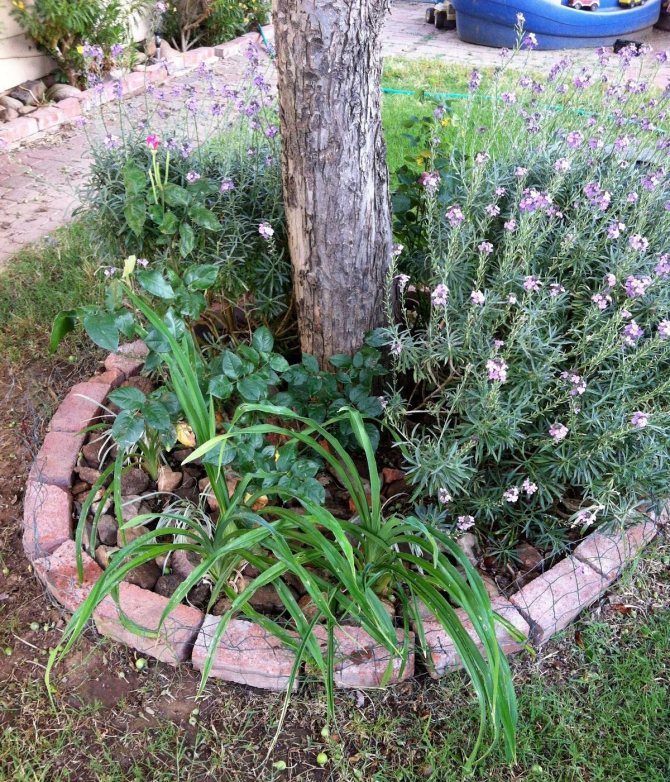

You should not make flower beds under fruit trees
Flower beds
This mistake is often made by summer residents, on whose plots there are many tall fruit trees. Often this is done not so much out of ignorance as because of a lack of space. There is practically nowhere to plant flowers, or you want to break shady flower beds, and there is simply no other shadow, except from adult fruit ones.
I made this mistake many times, and each time I regretted such a decision. I set up my first shady flower garden at my parents' dacha under an old apple tree. As a result, the bombardment of ripe fruits once every two years turned my flower garden into a battlefield, and it seriously lost its decorative effect.
The second time I broke a flower garden under a plum tree, but when my relatives were harvesting, they unintentionally trampled and broke the plants. The third flower garden was laid out at my own summer cottage under the cherry, but here it was not without excesses, since the cherry growth required constant removal and made maintenance difficult.
Based on this unpleasant experience, I made a firm decision: the orchard is only separate from the flowers!
Dear Readers! Despite many mistakes, today our first dacha is a well-groomed fragrant area, so unlike the one in which we got it from the old owners. When they ask me if I regret buying a dacha, which I had to sell just five years after the acquisition, I answer that I am not sorry - it gave me invaluable experience.I'm sure my new garden will be even better, because we will create it taking into account past oversights.

